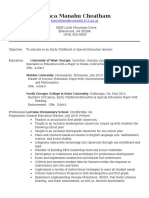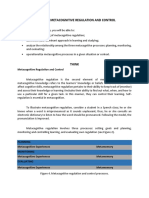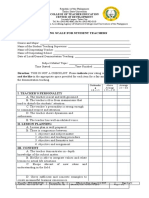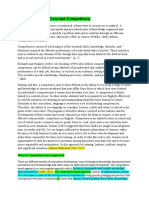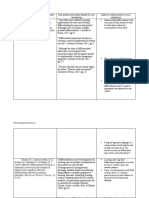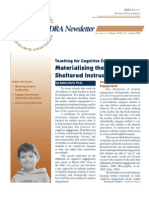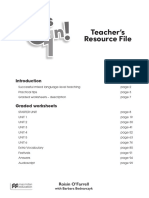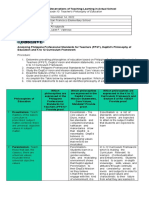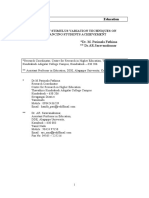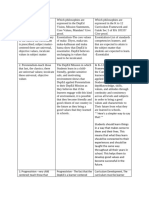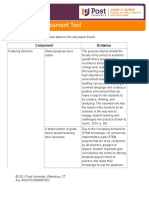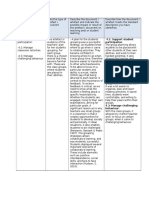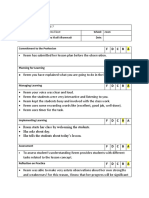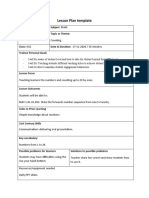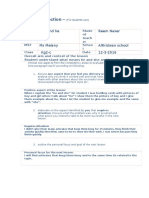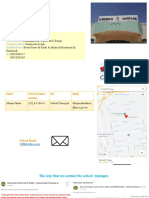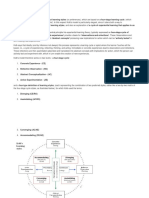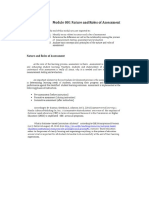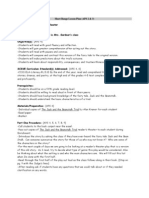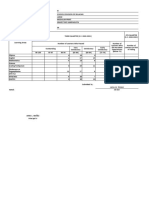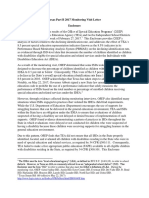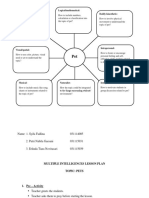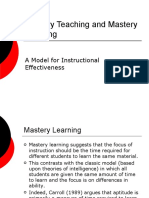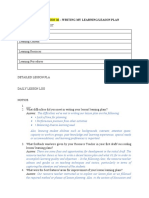GRM Fisher
GRM Fisher
Uploaded by
api-316412817Copyright:
Available Formats
GRM Fisher
GRM Fisher
Uploaded by
api-316412817Original Title
Copyright
Available Formats
Share this document
Did you find this document useful?
Is this content inappropriate?
Copyright:
Available Formats
GRM Fisher
GRM Fisher
Uploaded by
api-316412817Copyright:
Available Formats
Effective Use of
the Gradual Release
of Responsibility Model
By
Dr. Douglas Fisher
Professor of Language and Literacy Education
San Diego State University
Evidence on effective instruction is The Gradual Release of
accumulating at an amazing rate. Responsibility Model
We know that all learners need
A common way that teachers can
purposeful instruction in reading
do this is to use a gradual release
skills and strategies, motivation
of responsibility model (Pearson
to read, access to a wide
& Gallagher, 1983). The gradual
variety of texts, and authentic
release of responsibility model
opportunities to read and write
of instruction requires that the
both inside and outside of school
teacher shift from assuming “all
(Farstrup & Samuels, 2002; Fink
the responsibility for performing
& Samuels, 2008). We also know
a task … to a situation in which
that students need to develop
the students assume all of the
their expertise in all aspects of
responsibility” (Duke & Pearson,
reading and writing, including
2002, p. 211). This gradual release
oral language, phonemic awareness, phonics,
may occur over a day, a week, a month, or a
vocabulary, fluency, and comprehension (Frey &
year. Stated another way, the gradual release of
Fisher, 2006). And we also know that the skills of
responsibility “… emphasizes instruction that
the teacher, and how the teacher uses valuable
mentors students into becoming capable thinkers
instructional time, matters.
and learners when handling the tasks with which
This evidence on effective literacy teaching, they have not yet developed expertise” (Buehl,
which includes small group instruction, 2005).
differentiation, and a response to intervention,
The gradual release of responsibility model of
presents a challenge for many teachers and
instruction has been documented as an effective
schools. Clearly, whole-class instruction will not
approach for improving literacy achievement
work to improve the literacy achievement of our
(Fisher & Frey, 2007), reading comprehension
children. To be effective, teachers have engaged
(Lloyd, 2004), and literacy outcomes for English
students in purposeful instruction designed to
language learners (Kong & Pearson, 2003).
meet the needs of individual and smaller groups
of students.
6641_Douglas_Fisher_4pg.indd 1 12/2/08 10:19:42 AM
EFFECTIVE USE OF THE GRADUAL RELEASE OF RESPONSIBILITY MODEL
Components of the Gradual Release of • Independent work. As the goal of all of
Responsibility Model our instruction, independent learning provides
students practice with applying information
As delineated in the visual representation in in new ways. In doing so, students synthesize
Figure 1 (Fisher & Frey, 2008), there are four information, transform ideas, and solidify their
interactive (or interrelated) components of a understanding.
gradual release of responsibility model:
Importantly, the gradual release of responsibility
• Focus Lessons. This component allows model is not linear. Students move back and
the teacher to model his or her thinking and forth between each of the components as they
understanding of the content for students. master skills, strategies, and standards.
Usually brief in nature, focus lessons establish the
purpose or intended learning outcome and clue
students into the standards they are learning.
How is the Gradual Release of
In addition to the purpose and the teacher Responsibility Used?
model, the focus lesson provides teachers and The gradual release of responsibility model
opportunity to build and/or activate background provides teachers with an instructional
knowledge. framework for moving from teacher knowledge
to student understanding and application. The
• Guided Instruction. During guided gradual release of responsibility model ensures
instruction, teachers prompt, that students are supported in
question, facilitate, or lead their acquisition of the skills and
students through tasks that strategies necessary for success.
increase their understanding
of the content. While this can, Implementing the gradual
and sometimes does, occur with release of responsibility model
the whole class, the evidence
“As part of a gradual
requires time. Instructional
is clear that reading instruction release of responsibility planning can consume hours of
necessitates small group model, curriculum must a teacher’s time. As teachers,
instruction. Guided instruction be vertically aligned.” we have to plan for a diverse
provides teachers an opportunity group of learners, students
to address needs identified learning English, students who
on formative assessments and find reading easy and those
directly instruct students in who struggle, and students who
specific literacy components, need strategic intervention to be
skills, or strategies. successful. As part of a gradual
release of responsibility model, curriculum must
• Collaborative Learning. To consolidate be vertically aligned. Our students do not have
their understanding of the content, students time to waste on skills and strategies they have
need opportunities to problem solve, discuss, already mastered. Similarly, without strong
negotiate, and think with their peers. vertical alignment as part of the gradual release
Collaborative learning opportunities, such as of responsibility model, skills can be missed.
workstations ensure that students practice and
apply their learning while interacting with their What is vertical alignment?
peers. This phase is critical as students must
Vertical alignment is both a process and an
use language if they are to learn it. The key to
outcome, the result of which is a comprehensive
collaborative learning, or productive group work
curriculum that provides learners with a coherent
as it is sometimes called, lies in the nature of the
sequence of content. Vertical alignment
task. Ideally each collaborative learning task will
ensures that content standards and reading
have a group function combined with a way to
skills and strategies are introduced, reinforced,
ensure individual accountability such that the
and assessed. Vertical alignment guarantees
teacher knows what each student did while at
the workstation.
6641_Douglas_Fisher_4pg.indd 2 12/2/08 10:19:43 AM
EFFECTIVE USE OF THE GRADUAL RELEASE OF RESPONSIBILITY MODEL
that instruction is targeted on the intersection Farstrup, A. E. and S. J. Samuels (eds.), What
between student needs and content standards. the Research has to Say About Reading
In curricula with strong vertical alignment, Instruction, 3rd ed., International Reading
content redundancy is reduced and the Association, Newark, Delaware, 2002.
curriculum is rigorous and challenging.
Fink, R. and S. J. Samuels (eds.), Inspiring
Reading Success: Interest and Motivation in
Why is vertical alignment important? an Age of High-Stakes Testing, International
First and foremost, strong vertical alignment Reading Association, Newark, Delaware,
accommodates a wide variety of developmental 2008.
levels and is designed to increase the
intellectual, personal, physical, social, and career Fisher, D. and N. Frey, “Implementing a
development of all students. Vertical alignment Schoolwide Literacy Framework: Improving
allows teachers increased precision in their Achievement in an Urban Elementary
teaching because they are not teaching content School,” The Reading Teacher, 61, 2007, pp.
that is covered elsewhere or that students have 32-45.
mastered previously. Vertical alignment also
ensures that specific content standards are Fisher, D. and N. Frey, Better Learning Through
not entirely missed as a teacher at one grade Structured Teaching: A Framework for
assumes someone else focused on that content. the Gradual Release of Responsibility,
Association for Supervision and Curriculum
Development, Alexandria, Virginia, 2008.
Conclusion
Frey, N. and D. Fisher, Language Arts Workshop:
With strong vertical alignment and purposeful Purposeful Reading and Writing Instruction,
instruction, students learn. While there are many Merrill Education, Upper Saddle River, New
reasons that children struggle with reading Jersey, 2006.
and writing, there are not endless numbers
of solutions. Students who find literacy tasks Kong, A. and P. D. Pearson, “The Road to
difficult deserve increased attention from their Participation: The Construction of a Literacy
teachers, quality reading materials, and authentic Practice in a Learning Community of
opportunities to read and write. If we provide Linguistically Diverse Learners,” Research in
them with these essentials, we can expect great the Teaching of English, 38, 2003, pp. 85-
things. If we do not, we cannot expect students 124.
to know themselves or their world.
Lloyd, S. L., “Using Comprehension Strategies as
a Springboard for Student Talk,” Journal of
References Adolescent and Adult Literacy, 48, 2004, pp.
Buehl, D, “Scaffolding,” Reading Room, 2005, 114-124.
<www.weac.org/News/2005-06/sept05/
readingroomoct05.htm> (November 11, Pearson, P. D. and M. C. Gallagher, “The
2006). Instruction of Reading Comprehension,”
Contemporary Educational Psychology, 8,
Duke, N. K. and P. D. Pearson, “Effective 1983, pp. 317-344.
Practices for Developing Reading
Comprehension,” in A. E. Farstup & S. J.
Samuels (eds.), What Research has to Say
About Reading Instruction, International
Reading Association, Newark, Delaware,
2002, pp. 205-242.
6641_Douglas_Fisher_4pg.indd 3 12/2/08 10:19:44 AM
EFFECTIVE USE OF THE GRADUAL RELEASE OF RESPONSIBILITY MODEL
Teacher Responsibility
Focus Lesson “I do it”
Guided
Instruction “We do it”
“You do it
Collaborative
together”
“You do it
Independent alone”
Figure 1
RD 08 W 6641
12/08 10M
6641_Douglas_Fisher_4pg.indd 4 12/2/08 10:19:45 AM
You might also like
- Co-Teaching Models and Paraeducator Action Plan-C. YoungDocument7 pagesCo-Teaching Models and Paraeducator Action Plan-C. YoungCalandra YoungNo ratings yet
- The Sett Framework Blank Template 1 1Document2 pagesThe Sett Framework Blank Template 1 1api-455916230No ratings yet
- Gradual Release of Responsibility Doug FisherDocument4 pagesGradual Release of Responsibility Doug Fisherapi-239565419No ratings yet
- Module 1 - FLCTDocument21 pagesModule 1 - FLCTShe Na - mNo ratings yet
- Bianca Cheatham - Resume 1Document4 pagesBianca Cheatham - Resume 1api-377835688No ratings yet
- An Instructional Design Model To Help ASSURE Effective Teaching & LearningDocument4 pagesAn Instructional Design Model To Help ASSURE Effective Teaching & LearningJoyce Bringas100% (1)
- Module 1B - Metacognitive Regulation and ControlDocument7 pagesModule 1B - Metacognitive Regulation and ControlMichelle Casin100% (1)
- The Dominance FactorDocument3 pagesThe Dominance FactorClare CooneyNo ratings yet
- Sped 3rd Observation Lesson PlanDocument2 pagesSped 3rd Observation Lesson Planapi-243298110No ratings yet
- Rating Scale For Student TeachersDocument3 pagesRating Scale For Student TeachersMark100% (2)
- Definition of The Concept CompetencyDocument8 pagesDefinition of The Concept CompetencyLina KetfiNo ratings yet
- Teaching EffectivenessDocument36 pagesTeaching Effectivenesscivil2k7No ratings yet
- Data Collect 3Document4 pagesData Collect 3api-400377867No ratings yet
- Episode 16Document5 pagesEpisode 16gumabunjohncrisNo ratings yet
- Educational ObjectivesDocument12 pagesEducational ObjectivesmarciafdixonNo ratings yet
- Investigcion 4 UceDocument4 pagesInvestigcion 4 UceJefrey DavidNo ratings yet
- Problems and Challenges Encountered by Students in Management Accounting - Basis For Curriculum DevelopmentDocument7 pagesProblems and Challenges Encountered by Students in Management Accounting - Basis For Curriculum DevelopmentAuguste Anthony SisperezNo ratings yet
- PMCFDocument2 pagesPMCFArnel TatoyNo ratings yet
- Difficulties in Reading Comprehension For StudentsDocument10 pagesDifficulties in Reading Comprehension For StudentsLawrence Albert MacaraigNo ratings yet
- Kids Can - 1 - TRF - IntroductionDocument7 pagesKids Can - 1 - TRF - IntroductionkoraliczekNo ratings yet
- Receiving Teachers Teaching Efficacy and Performance in A Secondary SchoolDocument7 pagesReceiving Teachers Teaching Efficacy and Performance in A Secondary SchoolPsychology and Education: A Multidisciplinary JournalNo ratings yet
- Something For Everyone Graded Worksheets Pedagogical HandbookDocument7 pagesSomething For Everyone Graded Worksheets Pedagogical HandbookJose Manuel AlcantaraNo ratings yet
- Proposed In-Service Training For Inclusive Education in The New NormalDocument3 pagesProposed In-Service Training For Inclusive Education in The New NormalMerry Jaine LiwanagNo ratings yet
- Edup211 - Week 1Document3 pagesEdup211 - Week 1KHRIZZA PAULETTE ANTIFORDA VEGANo ratings yet
- Episode 16 Pinca JenDocument6 pagesEpisode 16 Pinca JenJEN MARIEL PINCANo ratings yet
- KC1 SFE IntroductionDocument6 pagesKC1 SFE IntroductionJose Manuel AlcantaraNo ratings yet
- FIELD-STUDY-1-E7-Utilizing-Teaching-Learning-Resources-and-ICTDocument9 pagesFIELD-STUDY-1-E7-Utilizing-Teaching-Learning-Resources-and-ICTLawrence TaborlupaNo ratings yet
- Strategies To Improve As A Student: Learning Process Maria Fernanda MezaDocument3 pagesStrategies To Improve As A Student: Learning Process Maria Fernanda MezaKatherine OrtegaNo ratings yet
- FS1 LE 10 Act 1 1Document9 pagesFS1 LE 10 Act 1 1iii meeNo ratings yet
- International Journal of Qualitative Studies in EducationDocument19 pagesInternational Journal of Qualitative Studies in EducationReylian Prealdream AnarekaNo ratings yet
- Product 4: Teacher: Janin Vergara Rivera Jonathan Godinez Quijano 26/11/202Document4 pagesProduct 4: Teacher: Janin Vergara Rivera Jonathan Godinez Quijano 26/11/202Losiram Gnez QnoNo ratings yet
- CSTP 3 Mora 7 14 23Document8 pagesCSTP 3 Mora 7 14 23api-679271053No ratings yet
- 2 AnswerDocument7 pages2 AnswerChris PresentacionNo ratings yet
- ABANAS Module 3 Lesson 3 WorksheetDocument3 pagesABANAS Module 3 Lesson 3 WorksheetCharlynjoy Abañas100% (1)
- Colorful Pastel Childish Bubble Scheme Concept Mind Map GraphDocument2 pagesColorful Pastel Childish Bubble Scheme Concept Mind Map GraphAnghela Jhoselyn Cotrina DíazNo ratings yet
- Research Paper Education: Dr. M. Parimala Fathima DR - AR.SaravanakumarDocument9 pagesResearch Paper Education: Dr. M. Parimala Fathima DR - AR.SaravanakumarJoan JohnNo ratings yet
- Rex Comp SRB 2014 UsDocument7 pagesRex Comp SRB 2014 UsMr.Nasser HassanNo ratings yet
- Production of Social Studies: Prepared By: Iciah Jesalva Bse Major in Social StudiesDocument22 pagesProduction of Social Studies: Prepared By: Iciah Jesalva Bse Major in Social StudiesICIAH ALANA NADINE JESALVANo ratings yet
- Philosophies of EducationDocument7 pagesPhilosophies of EducationIah Lorea HangadNo ratings yet
- FS3 Learning Task 3.Document7 pagesFS3 Learning Task 3.Tabios EricaNo ratings yet
- Ce Nguyen Van Loi (118 125) 057Document8 pagesCe Nguyen Van Loi (118 125) 057Lê Phương Cẩm TúNo ratings yet
- Imarie and Jack Literature MapDocument3 pagesImarie and Jack Literature MapImarie May Rafuela EliotNo ratings yet
- 2007 - Crabbe - Learning Opportunities Adding Learning Value To TasksDocument9 pages2007 - Crabbe - Learning Opportunities Adding Learning Value To Tasksophelia elisa novitaNo ratings yet
- English Didactic - (518022a - 1141) Liseth MahechaDocument16 pagesEnglish Didactic - (518022a - 1141) Liseth MahechaLiseth MahechaNo ratings yet
- Teacher Role in The Student Centred ClassroomDocument10 pagesTeacher Role in The Student Centred ClassroomConstanza J. Cabaña AlvearNo ratings yet
- Differenciated Instructiion - ENS Graduados Approach Card 2024Document2 pagesDifferenciated Instructiion - ENS Graduados Approach Card 2024Humberto LozanoNo ratings yet
- Quantitative Impact of A Cognitive Modeling Intelligent Tutoring System On Student Performance in Balancing Chemical EquationsDocument5 pagesQuantitative Impact of A Cognitive Modeling Intelligent Tutoring System On Student Performance in Balancing Chemical EquationsJonathanNo ratings yet
- Fs 1 Episode 16 AnswerDocument4 pagesFs 1 Episode 16 Answermadelene gatuteo100% (2)
- Edu 609 D 8Document7 pagesEdu 609 D 8api-610591673No ratings yet
- Standard 4Document1 pageStandard 4api-354705018No ratings yet
- Annotation Four - Lesson Plan For Year Six On Developing Emotional WellbeingDocument7 pagesAnnotation Four - Lesson Plan For Year Six On Developing Emotional Wellbeingapi-355545812No ratings yet
- A. Professional Development For Language Teachers-GABRIEL H. DIAZ-MAGGIOLIDocument2 pagesA. Professional Development For Language Teachers-GABRIEL H. DIAZ-MAGGIOLIThư Thư LêNo ratings yet
- ASL 1 Research PaperDocument32 pagesASL 1 Research PaperMarilyn TamboonNo ratings yet
- Developing Speaking Skill Through Task-Based MaterialsDocument6 pagesDeveloping Speaking Skill Through Task-Based MaterialsWendy FernandoNo ratings yet
- M3L3 PintalDocument4 pagesM3L3 PintalMaris daveneNo ratings yet
- Borko 2010Document9 pagesBorko 2010Lilmal SihamNo ratings yet
- Colorful Pastel Childish Bubble Scheme Concept Mind Map GraphDocument2 pagesColorful Pastel Childish Bubble Scheme Concept Mind Map GraphAnghela Jhoselyn Cotrina DíazNo ratings yet
- On Teacher's Philosophy of Education: Field Study 1Document11 pagesOn Teacher's Philosophy of Education: Field Study 1Mikee Galla100% (5)
- Encouraging Reflective PractiseDocument7 pagesEncouraging Reflective PractisejiyaskitchenNo ratings yet
- Guidelines For Language Classroom InstructionDocument8 pagesGuidelines For Language Classroom InstructionEntoc, Diane Jean B.No ratings yet
- Educ526 Growthassessment Nunez Eric 05 28 2017finaleditDocument13 pagesEduc526 Growthassessment Nunez Eric 05 28 2017finaleditapi-344988008No ratings yet
- cstp3 Kim 5Document10 pagescstp3 Kim 5api-622501046No ratings yet
- FS 1 Episode 16Document9 pagesFS 1 Episode 16Kimchi Maarang100% (4)
- Field Study Overview JournalDocument7 pagesField Study Overview JournalJohn VibarNo ratings yet
- The Rizal Memorial Colleges, Inc.: internet-CMO-No.20-2013 PDFDocument4 pagesThe Rizal Memorial Colleges, Inc.: internet-CMO-No.20-2013 PDFRonibe B MalinginNo ratings yet
- Curriculum Compacting: An Easy Start to Differentiating for High Potential StudentsFrom EverandCurriculum Compacting: An Easy Start to Differentiating for High Potential StudentsRating: 5 out of 5 stars5/5 (1)
- MCT 1Document1 pageMCT 1api-316412817No ratings yet
- Professional Development Plan EPC4909 Semester 8: Competenc y GoalDocument5 pagesProfessional Development Plan EPC4909 Semester 8: Competenc y Goalapi-316412817No ratings yet
- Weekly Journal: (Week Six)Document1 pageWeekly Journal: (Week Six)api-316412817No ratings yet
- Creative CVDocument1 pageCreative CVapi-316412817No ratings yet
- Weekly Journal: (Week Seven)Document1 pageWeekly Journal: (Week Seven)api-316412817No ratings yet
- Weekly Journal: (Week Four)Document1 pageWeekly Journal: (Week Four)api-316412817No ratings yet
- 2-Reem ObservationDocument2 pages2-Reem Observationapi-316412817No ratings yet
- Math 3Document3 pagesMath 3api-316412817No ratings yet
- 1-Reem Naser Hamad Salem Alkarbi h00293411 S 7 FirstDocument1 page1-Reem Naser Hamad Salem Alkarbi h00293411 S 7 Firstapi-316412817No ratings yet
- Reem CVDocument1 pageReem CVapi-316412817No ratings yet
- Weekly Journal: (Week Five)Document1 pageWeekly Journal: (Week Five)api-316412817No ratings yet
- 4-Reem NaserDocument2 pages4-Reem Naserapi-316412817No ratings yet
- WelcomingDocument8 pagesWelcomingapi-316412817No ratings yet
- Reem Adhraa KhwlahDocument3 pagesReem Adhraa Khwlahapi-316412817No ratings yet
- Assessment 1 Presentation Criteria ReemDocument2 pagesAssessment 1 Presentation Criteria Reemapi-316412817No ratings yet
- She and He Lesson ReflectionDocument1 pageShe and He Lesson Reflectionapi-316412817No ratings yet
- Interview Presentation2Document19 pagesInterview Presentation2api-316412817No ratings yet
- E-Phonics Lesson ReflectionDocument1 pageE-Phonics Lesson Reflectionapi-316412817No ratings yet
- He and She Lesson PlanDocument1 pageHe and She Lesson Planapi-316412817100% (2)
- Math Lesson PlanDocument2 pagesMath Lesson Planapi-316412817No ratings yet
- Lecture 1Document2 pagesLecture 1Jutix StardollNo ratings yet
- Kolb 2Document25 pagesKolb 2nurmalajamaludin100% (1)
- Communication Aids and Strategies Using Tool of Technology: Mam SalveDocument19 pagesCommunication Aids and Strategies Using Tool of Technology: Mam SalveRonizza ElardoNo ratings yet
- Active Learners EssayDocument7 pagesActive Learners Essayapi-358204419No ratings yet
- Department of Education: Weekly Learning Activity PlanDocument2 pagesDepartment of Education: Weekly Learning Activity PlanSaz RobNo ratings yet
- Educ241 (1-3)Document37 pagesEduc241 (1-3)Airess Tifany100% (1)
- Constructivism & Zone of Proximal Development Connectivism Conditions & Categories of LearningDocument1 pageConstructivism & Zone of Proximal Development Connectivism Conditions & Categories of Learningapi-267507541No ratings yet
- Readers Theater Lesson - Formal 1Document2 pagesReaders Theater Lesson - Formal 1api-218829059No ratings yet
- Peer & Self Evaluation RevisedDocument2 pagesPeer & Self Evaluation RevisedRudy NurdinNo ratings yet
- Project U-Sparc InitiativeDocument17 pagesProject U-Sparc Initiativeapi-283935863No ratings yet
- 18.4 Lesson Plan Prince and The ThievesDocument3 pages18.4 Lesson Plan Prince and The ThievesFaruq HusainiNo ratings yet
- Data On Learners Grades For The Third Quarter of The School Year 2020 2021 1two Sampaguita 1Document2 pagesData On Learners Grades For The Third Quarter of The School Year 2020 2021 1two Sampaguita 1Angela Maniego MendozaNo ratings yet
- Dept. of Education Texas SPED ReportDocument14 pagesDept. of Education Texas SPED ReportAlejandra Matos100% (2)
- Differentiated Instruction in Relation To Pupils' Learning StyleDocument15 pagesDifferentiated Instruction in Relation To Pupils' Learning Styletabishkh1No ratings yet
- Syifa Fadlina, Putri Nabila, Erlinda Tiara - Multiple Intelligences Lesson PlanDocument4 pagesSyifa Fadlina, Putri Nabila, Erlinda Tiara - Multiple Intelligences Lesson PlanPutri NabilaNo ratings yet
- Mastery Teaching and Mastery Learning: A Model For Instructional EffectivenessDocument15 pagesMastery Teaching and Mastery Learning: A Model For Instructional EffectivenessOnetoo JoshNo ratings yet
- Science 6 Lesson 17Document2 pagesScience 6 Lesson 17api-300873678No ratings yet
- Katherine Godinez: Career ObjectiveDocument2 pagesKatherine Godinez: Career Objectiveapi-557220473No ratings yet
- Fs 2 - Learning Episode 10 - Writing My Learning/Leason PlanDocument3 pagesFs 2 - Learning Episode 10 - Writing My Learning/Leason PlanChuck Garrido73% (15)
- Table of Amendment in ResubmissionDocument3 pagesTable of Amendment in ResubmissionLam SumNo ratings yet
- Talent Is Overrated Book SummaryDocument2 pagesTalent Is Overrated Book SummaryTarheel66890% (10)
- OC DLL Grade 11 2nd WeekDocument4 pagesOC DLL Grade 11 2nd WeekRowilyn Seat IINo ratings yet
- Supervisor Observation Reflection 1Document7 pagesSupervisor Observation Reflection 1api-427875728No ratings yet




